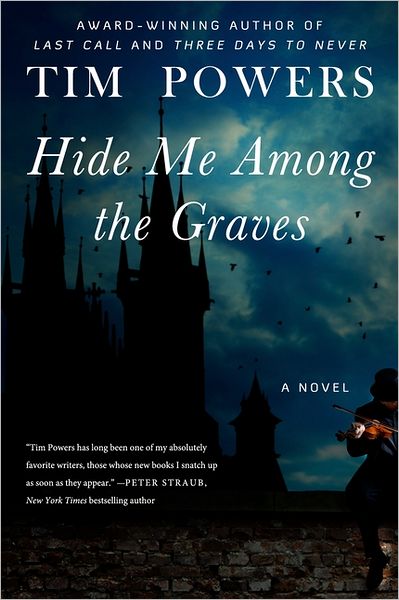
I’m a Tim Powers fan. Most of his books are my go-to reading when I’m in a funk or otherwise needing a jolt of industrial magic realism. I’ve given away more copies of Last Call and On Stranger Tides than I can remember, never expecting to get them back.
His books are a gold standard: the earlier ones (Skies Discrowned, The Drawing of the Dark, The Anubis Gates, On Stranger Tides) being full-on adventures, usually historical, involving secret histories that play with the facts for their own supernatural ends; the later ones (Last Call, Declare) continue to work with secret histories, though with more intricate plots and greater focus on the historical details.
Hide Me Among the Graves is no less intricately plotted or historically bent — or supernatural, for that matter — though this one fails to catch the same light.
Graves is somewhat of a sequel to The Stress of Her Regard, Powers’ 1989 novel involving a hapless London doctor, John Keats, Lord Byron, Percy Shelley, and the nephilim — that race of giants from the Bible, angel sired and of woman born — who, in this case somehow turned to stony creatures and now live off the blood of humans. In Powers’ version, nephilim are the basis of the vampire legend, but instead of killing the humans to whom they are married or are in other ways part of the family, the nephilim give them longer life and the ability to write great poetry. (There is a big difference between being family and being food and the nephilim are jealous creatures; anyone attached to their beloved either has her chest crushed or is drained and can come back as a vampire himself.) Naturally, the whole thing is a little more complicated than that, but you get the idea. All this takes place in Italy in the early 1800’s.
One of the lesser players in Stress was John Polidori, physician to Lord Byron and runner-up in the Villa Diodati Ghost Story Contest — his tale, “The Vampyre” coming in second to Mary Shelly’s Frankenstein. Because of his employer’s notorious and scandalous reputation, Polidori was paid to keep a diary during their travels together, which he did, and which was later edited by his nephew, William Rossetti.
Polidori was a sub-minor character in Stress, portrayed as a dope and a wannabe, his literary aspirations leading him to seek a vampire and eventually becoming one — too bad for him since the nephilim were defeated by the end of the book and all the vampires turned to lifeless stone. The vampire Polidori was trapped a small, pointy black rock. Then, in 1845, he was able to regain himself thanks to a bit of exceptionally poor parenting by William Rossetti’s father, Gabriel, who gave the cursed stone to his fourteen-year old daughter, Christina.
Getting beyond the fact that an elderly father adores his daughter so much that he gives her the stone heart of a vampire along with explicit instructions on how to revive it , the daughter doesn’t seem to be the main character in this book, nor is anyone in the Rossetti family. Powers’ seems to want the main characters to be the son of the doctor from the first book, a woman with whom he had a one-night stand, and their own young daughter who is being pursued through London by Polidori. The Rossetti’s history is the backdrop and the family members are characters of varying importance in a story that ranges over forty years, roughly. And I do mean roughly.
There are moments — parts of chapters when the action picks up, where the stakes are evident or the emotion is tight — but they are too infrequent for the jacket copy to justifiably claim the story is, “an edge-of-your-seat thrill ride,” or for Booklist to say it’s a “nail-biter” with “breakneck pace.” I will, however, agree it has a “labyrinthine plot [pulling] us through history, mythology, mystery, and horror with [Powers’] signature creative verve.”
Indeed. But for a novel about vampires, doomed souls, and the need to save one’s most-loved, Hide Me Among the Graves lacks an overall urgency or even a sustained tension. And in spite of the risks around them, the main(ish) characters never seemed to be in any serious danger. This could also be due to their being fairly standard Types in Powers’ world and, therefore, harboring no surprises. The supporting character who stole the show was Edward Trelawny — a surly old writer and adventurer, and a friend of Lord Byron’s who was, in his younger days, in thrall to the nephilim. Trelawny is a man who deserves his own book with the full Powers treatment.
As far as Hide Me Among the Graves goes, its lack of propulsion, sputtering narrative, and wandering focus are the same problems to be found in The Stress of Her Regard — a novel that, after several failed attempts to read over the years, I finally finished in anticipation of the new book. Reading them back-to-back seemed to reflect their flaws and refract their qualities, though qualities there still are.
Powers is a secret historian of the highest order, invoking the supernatural and fantastic to reveal the true engines of the world. His research and keen eye for the effects of wildly disparate — yet intimately twined — events is unsurpassed.
In Hide Me Among the Graves, Powers’ trademark play with the facts seems to have gotten slow & tight while trying to connect too many historical dots.
Hide Me Among the Graves by Tim Powers goes on sale March 13, 2012.
Support your local independent bookstore.